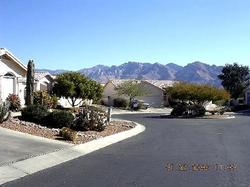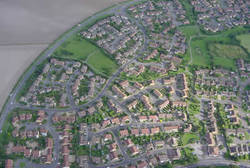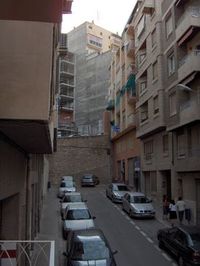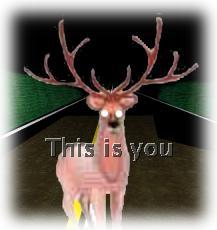
The worst feature of American life today may be the cul de sac.
Part of its evil lies in its popularity, in how many people find it to be good. To its defenders, a cul de sac is safety, and quiet. To developers a cul de sac is low costs and a guarantee of sales. Cul de sacs let you develop more of your land, and use less of it for roads or other civil amenities.
Most suburban development today takes place through cul de sacs. The original suburban road systems are not changed. This makes cul de sacs popular with governments, who feel they don’t really have to do anything in order to get all this "growth."
But people don’t stay inside their cul de sacs. They go places. They go to school, they go to work, they go to the store, they go to friends. And each time they go to any of these places, they have to leave the cul de sac, through the single shared entrance.
In other words they have to drive.

Cul de sacs force people to drive to go anywhere. There may be one
store at the main entrance to a cul de sac, and when a cul de sac
development is large enough the developer may hold out some land for
this purpose. But it’s just one store. Usually it’s a strip mall. One
strip mall. A single strip mall is not going to deliver all the
services you need. It’s not going to deliver choice.
So it’s off in the car. And most cul de sacs have no strip mall.
What happens to the road as more cul de sacs are built, the one
shared road? It jams with traffic. It fills with accidents, as
impatient drivers try to get in-and-out of the cul de sacs. Most
accidents happen within 15 minutes of home. Most accidents happen at
cul de sac entrances. Unless the cul de sac is big, it won’t have
enough traffic to justify a traffic signal, remember. Maybe just a stop
sign. What if there’s a hill? Or a turn in the road at the entrance of
the cul de sac? People pull out and oncoming traffic clips them, or
plows into them on the side.
As the land fills with suburban developments the road is filled with
cars. People no longer even think of doing anything but driving to get
anywhere, even if the road as a sidewalk. The noise, the pollution, the
danger from traffic, means kids can’t ride bikes, and must be
chauffeured everywhere. Kids get fat, kids stay dependent. As they get
friends, they must be driven to the friends’ houses.
Another thing happens as the road is filled with cars. All the
people who’ve bought in the cul de sacs start agitating for the road to
be expanded. This kills off the homes of those who bought homes before
the cul de sacs. The one thing I guarantee when a road leading to cul
de sacs is widened is that the lawns of these older homes are going to
be sacrificed to widen the road.
Now you’ve got a 5 lane road leading through the cul de sacs. Now
you’ve got traffic racing along at 60 miles per hour down the road. Now
no one thinks of doing anything but driving. To do anything.
If your luck is in an entire cul de sac may be sold for office
development. An office cul de sac develops. Now you have thousands of
cars going into and out of the cul de sac every day. You have to have a
light in front of every such development. And now the road doesn’t move
at all.
When you try to build a city on a suburban cul de sac plat, you get
gridlock. You just can’t widen the road enough to accommodate the
traffic. Everything is forced into this single center, and everything
stops. In the morning. In the evening. On the weekends. Near Christmas.
Cul de sac development guarantees sterility, no matter how much or
how little density you have. Cul de sac development is based on the
selfishness of developers who don’t want to pay for the impact their
projects cause, and the selfishness of buyers who don’t want to see
cars go down their roads.
You can’t cut through a cul de sac, even with a bike path. You have
to buy strips of land on each side of the adjoining cul de sacs, and
even if you do succeed, you’re going to get protests from people who
fear, perhaps rightly, that thieves will park on one side or the other
of the cut, to whisk away stuff from the other side.
The cul de sac makes the War Against Oil nearly impossible to win,
by guaranteeing that people of every age have only one way to get
around — the automobile. As cul de sac developments grow this
dependence increases.
Cul de sacs make you fat. They make you lazy. They give you the
illusion of security, but there’s plenty of crime in the cul de sacs.
Crooks have cars, and they know that there’s little traffic inside the
cul de sac. Drive up, smash, grab, drive away — chances are great no
one will see you.
And if anyone thinks being part of a "gated community" with a gatehouse protects the residents of a cul de sac from crime, think again. There’s crime there too. And much of it is never solved, again because there are no witnesses.
Cul de sacs are the symbol of what’s wrong with America. But they
have become so ubiquitous that no one can imagine building cities any
other way.
Time to start imagining.












Dana, the emergent failure modes of cul-de-sac planning are reasonably well known.
The solution is now reasonably well known too: Promulgating ‘Great Streets’ designs, which are desirable (for individual homeowners) for a different and competing set of qualities.
Eventually, I think we’ll see US suburban planning evolve to having relatively small cul-de-sac oriented burbclaves embedded in a larger great-streets mixed-use matrix.
Dana, the emergent failure modes of cul-de-sac planning are reasonably well known.
The solution is now reasonably well known too: Promulgating ‘Great Streets’ designs, which are desirable (for individual homeowners) for a different and competing set of qualities.
Eventually, I think we’ll see US suburban planning evolve to having relatively small cul-de-sac oriented burbclaves embedded in a larger great-streets mixed-use matrix.
Michael, that’s a great point. Small cul-de-sacs do work in keeping keeping down crime etc. They don’t scale up well, but I think that referring to them as “evil” is unwarranted hyperbole.
Your point of embedding them in a larger mixed-use matrix is right on the money.
http://www.greatstreets.org/
Michael, that’s a great point. Small cul-de-sacs do work in keeping keeping down crime etc. They don’t scale up well, but I think that referring to them as “evil” is unwarranted hyperbole.
Your point of embedding them in a larger mixed-use matrix is right on the money.
http://www.greatstreets.org/
Yeah, it’s those selfish homeowners who would like a safe place for their kids to ride their bikes. Much better to have the kids inside watching porn and playing video games. You go Dana!
Yeah, it’s those selfish homeowners who would like a safe place for their kids to ride their bikes. Much better to have the kids inside watching porn and playing video games. You go Dana!